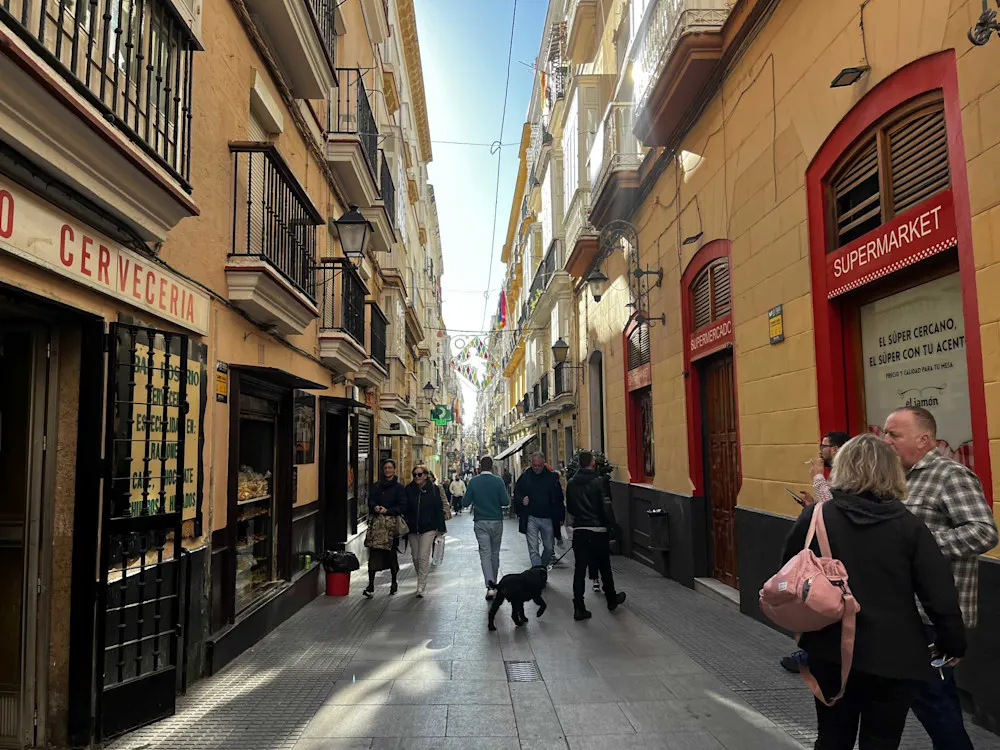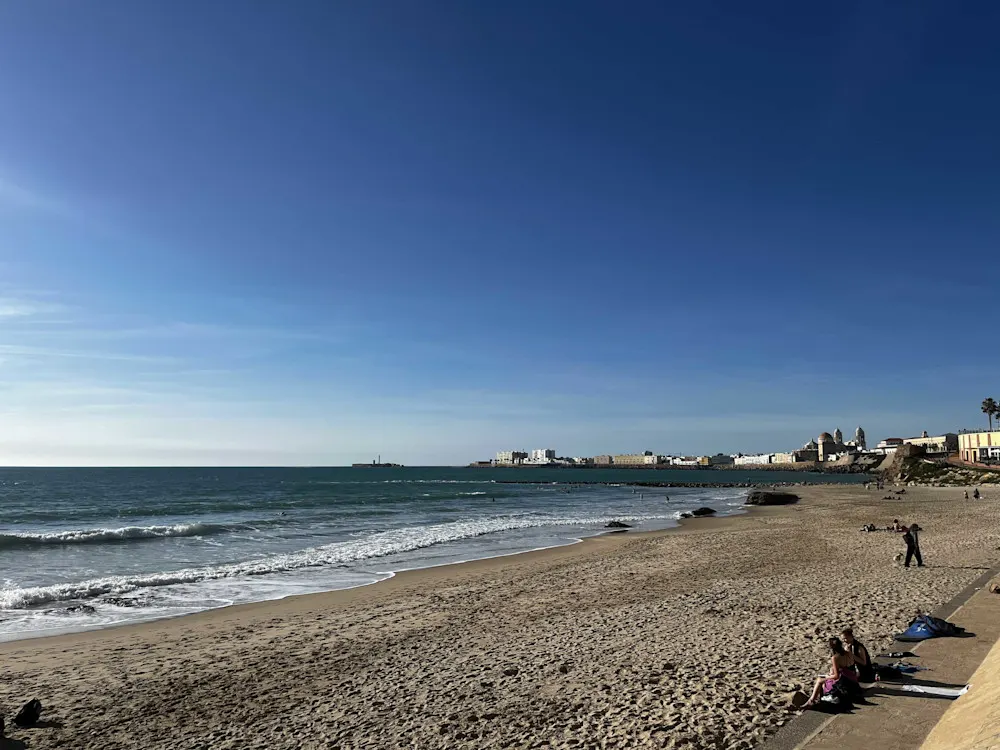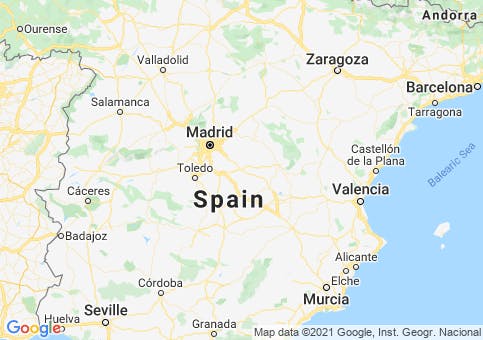Spain has long been a magnet for expats, with the Costa del Sol drawing European retirees in search of sunshine since the 1960s. More recently, Americans have caught on, fueling a new wave of interest in cities like Malaga. But with popularity comes rising prices. If you’re looking for a more affordable, under-the-radar alternative, Cadiz might be worth considering.
Located on Spain’s southwestern Atlantic coast, just west of Malaga, the province of Cadiz (which shares its name with its capital city) is a favorite summer destination for Spaniards but remains relatively undiscovered by expats. The city itself is a coastal gem—rich in history, lined with golden beaches, and exuding a laid-back charm that feels worlds away from the tourist-heavy spots further east.
As part of IL's Hidden Places Initiative, I spent four days in Cadiz, Spain, on a mission to see whether this coastal city could be a viable option for Americans looking to move abroad. I first visited Cadiz in 2008, and after 15 years, I was eager to return. Would it still have the same magic I remembered? More importantly—could it be the next great destination for expats looking for a new life abroad? I was on a mission to find out.
Get Your Free Spain Report Today!
Get Your Free Spain Report Today!
Learn more about the lower cost of living in Spain and other countries in our free daily postcard e-letter. Simply enter your email address below and we'll also send you a FREE REPORT — Live the Good Life in Sunny, Affordable Spain.

By submitting your email address, you will receive a free subscription to IL Postcards, Overseas Dream Home, The Untourist Daily and special offers from International Living and our affiliates. You can unsubscribe at any time, and we encourage you to read more about our Privacy Policy.
A City Steeped in History and Coastal Beauty

Cadiz is a city steeped in history, charm, and local authenticity. As one of the oldest continuously inhabited cities in Western Europe—dating back over 3,000 years—it has a rich and storied past. The Romans called it Gades, a name that gradually evolved into today’s Cadiz. Locals, known as gaditanos, take great pride in their heritage, and it’s easy to see why.
Situated on a narrow peninsula, Cadiz is almost entirely surrounded by the Atlantic Ocean, offering breathtaking waterfront views and a relaxed, beach-town atmosphere. Its old town, with winding cobblestone streets and lively plazas, reflects its Moorish past, with narrow alleyways designed to provide shade from the intense summer sun.
Often nicknamed “Little Havana,” Cadiz bears a striking resemblance to the Cuban capital, thanks to its architecture, grand cathedral, and scenic promenade. Unlike many Spanish cities, no building here is allowed to be taller than the cathedral, preserving the city’s distinctive skyline. While Cadiz has both an old town and a newer area, even the modern sections remain free from high-rise developments and sprawling resorts. Although European tourists flock here in summer, over-tourism hasn’t taken over, and the city still retains its unmistakably Spanish character.
Cadiz is also famous for its lively Carnaval, a ten-day celebration of music, satire, and elaborate costumes. It’s one of Spain’s most renowned festivals, drawing visitors from across the country. Be warned—its fast-paced, comical songs can be tricky to understand, even for native Spanish speakers!
If you’re considering making Cadiz home, a scouting trip is a must. Staying in one of the city’s historic palatial homes offers a real taste of its past. I stayed in a hotel that once served as the British Consulate during the Peninsular War in the 1800s! You might opt for Áurea Casa Palacio Sagasta or Casa Cánovas, both beautifully restored historic residences turned boutique hotels.
Lifestyle in Cadiz

Cadiz is a place that invites you to slow down. With its laid-back beach-town atmosphere, it’s perfect for those looking to escape the hustle of bigger cities. La Caleta and Santa María beaches are just a short walk from the old town, while Victoria and Cortadura stretch along the coastline, offering more space and tranquility.
The climate is another major perk. I visited in February and enjoyed mild, sunny days in the low 60s—ideal for exploring. It’s easy to see why people here take full advantage of outdoor activities year-round. Whether you’re into cycling, surfing, or simply strolling along the seaside, the weather makes it effortless to stay active.
Despite its small size, Cadiz is full of life. Narrow streets open up to lively plazas where locals of all ages gather at all hours. With 25% of the population over 65, there’s a strong sense of community—but don’t expect the city to sleep early. Like anywhere in Spain, dinner doesn’t start until 9.30 or 10 p.m., and evenings are filled with the hum of conversation and clinking glasses.
Cadiz isn’t known for international diversity. Its food scene is almost entirely Spanish, and much of its cultural life revolves around local traditions—flamenco, festivals, and historic heritage. While the city lacks major museums, theaters, and entertainment venues, nearby Jerez and Seville offer a wider variety of cultural experiences, including ballet, opera, and concerts.
Cost of Living

Housing in Cadiz is surprisingly affordable compared to major Spanish cities like Madrid, Barcelona, or even Malaga. The historic old town remains a lived-in, authentic neighborhood rather than a tourist trap. Walking through its winding streets, you’ll find local fruit and vegetable shops, bakeries, butcher shops, and small grocery stores, adding to its community charm. For larger supermarkets and more variety, the newer part of the city has plenty of options.
Groceries and dining out are reasonably priced, with Cadiz known for its fresh seafood. At one of the city’s legendary restaurants, I enjoyed a full meal—gambas al pilpil, patatas aliñadas, a whole sea bream for two, two glasses of wine, and dessert—all for just €65. The Mercado Central de Abastos is a favorite spot where locals shop for fresh ingredients and enjoy tapas in the sunshine.
To better understand the local real estate market, I met with Domingo at Innysse, who speaks some English and was incredibly helpful in explaining the landscape. You can contact them at info@innysse.es or visit www.innysse.es.
Because Cadiz is on a peninsula, housing development is limited, making availability competitive. While older buildings can be renovated, strict preservation rules make the process costly. That said, real estate remains of great value compared to Spain’s pricier cities. A small one- to two-bedroom property in need of some work starts at around €275,000—similar to Malaga’s pre-pandemic prices—while a move-in-ready two-bedroom in the historic center typically starts at €400,000.
For rentals, a renovated one- to two-bedroom unfurnished apartment can still be found for €850 per month, though most listings now start closer to €1,000. With increasing interest from European buyers, prices may continue to rise.
Get Your Free Spain Report Today!
Get Your Free Spain Report Today!
Learn more about the lower cost of living in Spain and other countries in our free daily postcard e-letter. Simply enter your email address below and we'll also send you a FREE REPORT — Live the Good Life in Sunny, Affordable Spain.

By submitting your email address, you will receive a free subscription to IL Postcards, Overseas Dream Home, The Untourist Daily and special offers from International Living and our affiliates. You can unsubscribe at any time, and we encourage you to read more about our Privacy Policy.
Accessibility and Infrastructure

Cadiz isn’t the easiest coastal city to reach—unlike Barcelona, Valencia, or Malaga, getting here takes a little extra effort. But that also means fewer crowds and a more relaxed atmosphere.
Once you arrive, though, the city is incredibly walkable. It’s flat, making it easy to explore on foot, by bike, or even via electric scooter along the seaside promenade. However, the old town’s cobblestone streets can be tricky if you have mobility concerns.
While public transportation exists, Cadiz isn’t the most well-connected city for frequent travelers. The nearest airport is in Jerez de la Frontera (about 45 minutes away), while Seville Airport is one hour and 15 minutes by car. Regular train services connect Cadiz to Seville (1.5 hours) and Madrid (five hours), with buses also providing an alternative for reaching nearby cities.
Driving in Cadiz can be an adventure—parking is limited in the old town, and many streets are pedestrian-only. If you have a car, expect to use a parking garage or find a spot on the outskirts. That said, having a car is a huge plus for exploring the region’s stunning towns and beaches. Rental cars in Spain are surprisingly affordable—I paid just €140 for four days, making it easy to venture beyond the city and soak up more of the Andalusian coast.
Community
Cadiz is one of the few places in Spain where you might go days without hearing a word of English—and honestly, I found that refreshing! The few foreigners I encountered were mainly French and Italian retirees who own second homes here, but even they were relatively scarce.
If you’re looking for full Spanish immersion, this is an ideal place to learn the language, though the Andalusian accent can be a challenge at first.
The city itself has a shrinking population of around 110,000, as many young locals move elsewhere for work. With the shipyards closing in the 1990s and Spain’s low birthrate, Cadiz isn’t exactly booming in numbers. But what it lacks in size, it makes up for in personality. The locals—proudly known as the funniest people in Spain—are warm and welcoming. It’s the kind of place where everyone knows each other, and if you frequent the same bakery or tapas bar, you’ll quickly feel like part of the community.
If you’re looking for a thriving expat scene, Cadiz might not be the best fit. However, digital nomads are slowly discovering the city, and with Jerez and Seville nearby, you’ll have access to a younger professional crowd when you need it.
The Verdict: A Hidden Gem on the Rise

After my visit, I feel confident in saying that Cadiz falls firmly into the “Up & Coming” category. Life here isn’t for everyone, but that’s exactly what makes it special. If you’re looking for an authentic Spanish experience—where locals know your name at the corner café, siesta is still taken seriously, and the sea breeze is part of daily life—this might just be the place for you.
For retirees, Cadiz offers a relaxed coastal lifestyle, a reasonable cost of living, and a tight-knit community, though it lacks the large expat networks found in other Spanish cities. Digital nomads might find fewer coworking spaces and networking opportunities, but if you’re after affordability, tranquility, and ocean views that double as a workspace, it’s worth considering.
As with any place, there are trade-offs. The job market is limited, English isn’t widely spoken, and getting here takes a little more effort. But for those who embrace slow living, fresh seafood, and historic charm—without the tourist crowds—Cadiz is a place that’s easy to fall in love with.

The World’s Best Retirement Havens for 2026
The World’s Best Retirement Havens for 2026
24 Countries Compared, Contrasted, Ranked, and Rated. You don’t have to be rich to enjoy a pampered retirement, you just need to know where to go. With our 35th Annual Global Retirement Index, our experts hand you a detailed roadmap. Details—and a Special Offer—Here

By submitting your email address, you will receive a free subscription to IL Postcards, Overseas Dream Home, The Untourist Daily and special offers from International Living and our affiliates. You can unsubscribe at any time, and we encourage you to read more about our Privacy Policy.















